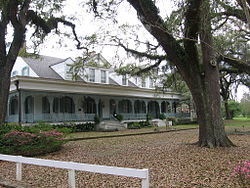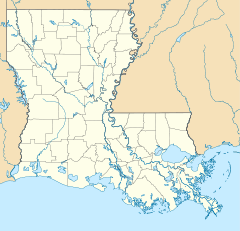- Myrtles Plantation
-
Myrtles Plantation

Location: U.S. 61, St. Francisville, Louisiana Coordinates: 30°48′11″N 91°23′15″W / 30.80306°N 91.3875°WCoordinates: 30°48′11″N 91°23′15″W / 30.80306°N 91.3875°W Area: 10 acres (4.0 ha) Built: 1797 Governing body: Private NRHP Reference#: 78001439[1] Added to NRHP: September 6, 1978 The Myrtles Plantation is an antebellum plantation in St. Francisville, Louisiana, near Baton Rouge. Listed on the National Register of Historic Places, the plantation is a bed and breakfast, and it offers historical and mystery tours.
Contents
History
The Myrtles Plantation was built in 1796 by General David Bradford and was called Laurel Grove at the time. General Bradford lived there alone for several years, until being pardoned for his role in the Whiskey Rebellion in 1799 when President Washington order him to be executed. He then moved his wife Elizabeth and their five children to the plantation from Pennsylvania. One of Bradford's law students, Clark Woodruff (or Woodroff) eventually married Bradford's daughter, Sara Mathilda, in 1817. After the death of David Bradford in 1808,[2] Clark and Sara Woodruff managed the plantation for Elizabeth Bradford. They had three children: Cornelia Gale, James, and Mary Octavia.[3]
When Elizabeth Bradford died in 1830, Clark Woodruff and his daughter Mary Octavia moved to Covington, Louisiana, and left a caretaker to manage the plantation. In 1834, Woodruff sold the plantation, the land, and its slaves to Ruffin Gray Stirling. Woodruff eventually died in New Orleans in 1851.
Stirling and his wife, Mary Catherine Cobb, undertook an extensive remodeling of the house. When completed, the new house was nearly double the size of the former building, and its name was changed to The Myrtles. They imported fancy furniture from Europe. The Stirlings had 9 children, but five of them died young. Stirling died in 1854 and left the plantation to his wife.[3]
In 1865, Mary Cobb hired William Drew Winter to help manage the plantation as her lawyer and agent. Winter was married to Mary Cobb's daughter, Sarah Stirling. Sarah and William Winter lived at the Myrtles and had six children, one of whom (Kate Winter) died from typhoid at the age of three. Although the Winters were forced to sell the plantation in 1868, they were able to buy it back two years later.[3]
In 1871, William Winter was shot by a suspected man named E. S. Webber on the porch of the house and within minutes died. Sarah remained at the Myrtles with her mother and siblings until 1878, when she died. Mary Cobb died in 1880, and the plantation passed to Stephen, one of her sons. The plantation was heavily in debt, however, and Stephen sold it in 1886 to Oran D. Brooks. Brooks sold it in 1889, and the house changed hands several times until 1891, when it was purchased by Harrison Milton Williams.[3]
20th century
Over the next several decades, the land was split up and owned by various Williams heirs. In the 1950s, Marjorie Munson owned the house itself. Munson apparently noticed odd things happening around the house and began to question neighbors about its history. This is possibly the beginning of some of the legends surrounding the Myrtles. The plantation changed hands several more times and was restored in the 1970s by owners Arlin Dease and Mr. & Mrs. Robert Ward. At some point the house changed hands again, being bought by James and Frances Kermeen Myers. The Myerses apparently believed the house was haunted, and it began to be featured in books and magazines about haunted houses. Frances, publishing as Francis Kermeen, has written a book about the Myrtles and its supposed haunting. The house, now owned by John & Teeta Moss, is now a bed & breakfast. Historical and mystery tours are also offered. The plantation house was listed on the National Register of Historic Places in 1978.[1][4]
Legends and ghost stories
Touted as "one of America's most haunted homes",[4] the plantation is supposedly home of at least 12 ghosts.[5] It is often reported that 10 murders occurred in the house,[5] but historical records only indicate the murder of William Winter.[3] In 2002, Unsolved Mysteries filmed a segment about the alleged hauntings at the plantation. According to host Robert Stack, the production crew experienced technical difficulties during the production of the segment.
The legend of Chloe
Possibly the most well known of the Myrtles supposed ghosts, Chloe was reportedly a slave owned by Clark and Sara Woodruff. According to one story, Clark Woodruff had pressured or forced Chloe into being his mistress[6] Other versions of the legend have Chloe listening in at keyholes to learn news of Clark Woodruff's business dealings or for other purposes. After being caught, either by Clark or Sara Woodruff, one of her ears was cut off, and she wore a green turban to hide it.
Chloe supposedly baked a birthday cake containing extract of boiled and reduced oleander leaves, which are extremely poisonous. The various legends diverge as to why she did this, a house maid whom was getting the favor of the mistress was a suspect with some saying she was getting revenge on the Woodruffs[5] and some saying she was attempting to redeem her position by curing the family of the poisoning. According to the legends, her plan backfired. Only Sara and her two daughters ate the cake, and all died from the poison. Chloe was then supposedly hanged by the other slaves, and thrown into the Mississippi River, either as punishment or to escape punishment by Clark Woodruff for harboring her.[5]
The historical record does not support this legend. There is no record of the Woodruffs owning a slave named Chloe, Cleo or any slaves. The legends usually claim that Sara and her two daughters were poisoned, but Mary Octavia survived well into adulthood. Finally, Sara, James, and Cornelia Woodruff were not killed by poisoning, but instead succumbed to yellow fever.[6] Regardless of the factual accuracy of the Chloe story, some believe a woman wearing a green turban haunts the plantation.[4]
Other legends
There are a variety of other legends surrounding the Myrtles. The house is reputedly built over an Indian burial ground, and the ghost of a young Indian woman has been reported.[5] During the Civil War, the house was ransacked by Union soldiers, and legend claims that three were killed in the house. Supposedly, there is (or was) a blood stain in a doorway, roughly the size of a human body, that will not (or would not) come clean. Other legends say that cleaners have been unable to push their mop or broom into that space.[3]
A mirror located in the house supposedly holds the spirits of Sara Woodruff and two of her children. According to custom, mirrors are covered after a death, but legend says that after the poisoning of the Woodruffs, this particular mirror was overlooked. The uncovered mirror reportedly trapped the spirits of Sara and her children, who are occasionally seen or leave handprints in the mirror.[7]
The plantation is also reportedly haunted by a young girl who died in 1868, despite being treated by a local voodoo practitioner. She supposedly appears in the room in which she died, and has been reported to practice voodoo on people sleeping in the room.[8]
There is also a ghost who reportedly walks, staggers, or crawls up the stairs and stops on the 17th step. Some have said that this is William Winter, the victim of the only verified murder in the house. He was shot on his front porch, staggered or crawled up the stairs, but collapsed, dead, on the 17th step. Alternate versions of his murder claim he managed to walk or crawl up the stairs, and collapsed in his wife's arms on the 17th step. However, this version of the story is contested.[3]
References
- ^ a b "National Register Information System". National Register of Historic Places. National Park Service. 2009-03-13. http://nrhp.focus.nps.gov/natreg/docs/All_Data.html.
- ^ [1] - National Park Service "Explore the History and Culture of Southeastern Louisiana"
- ^ a b c d e f g [2] - America's Most Haunted: Myrtles Plantation
- ^ a b c [3] - Official Site
- ^ a b c d e [4] - Myrtles Plantation Bed and Breakfast Haunted House
- ^ a b [5] - "Haunted Plantation - Myrtles Plantation Bed and Breakfast, St. Francisville, Louisiana" by Joe Nickell, Skeptical Inquirer, Septempter-October 2003, retrieved July 18, 2006
- ^ [6] - "Haunted Plantation - Myrtles Plantation Bed and Breakfast, St. Francisville, Louisiana" by Joe Nickell, Skeptical Inquirer, Septempter-October 2003, retrieved July 18, 2006
- ^ [7] - "Haunted Plantation - Myrtles Plantation Bed and Breakfast, St. Francisville, Louisiana" by Joe Nickell, Skeptical Inquirer, Septempter-October 2003, retrieved July 18, 2006
External links
- official Myrtles Plantation website -
- official Unexplained Apparitions Research Society website
- Unexplained paranormal investigative team's Myrtles Plantation field reports
U.S. National Register of Historic Places Topics Lists by states Alabama • Alaska • Arizona • Arkansas • California • Colorado • Connecticut • Delaware • Florida • Georgia • Hawaii • Idaho • Illinois • Indiana • Iowa • Kansas • Kentucky • Louisiana • Maine • Maryland • Massachusetts • Michigan • Minnesota • Mississippi • Missouri • Montana • Nebraska • Nevada • New Hampshire • New Jersey • New Mexico • New York • North Carolina • North Dakota • Ohio • Oklahoma • Oregon • Pennsylvania • Rhode Island • South Carolina • South Dakota • Tennessee • Texas • Utah • Vermont • Virginia • Washington • West Virginia • Wisconsin • WyomingLists by territories Lists by associated states Other  Category:National Register of Historic Places •
Category:National Register of Historic Places •  Portal:National Register of Historic PlacesCategories:
Portal:National Register of Historic PlacesCategories:- Plantations in Louisiana
- Historic house museums in Louisiana
- Museums in West Feliciana Parish, Louisiana
- Houses on the National Register of Historic Places in Louisiana
- Legends
- Reportedly haunted locations in the United States
- Bed and breakfasts in the United States
- Houses completed in 1797
- Classical Revival architecture in Louisiana
- Antebellum architecture
Wikimedia Foundation. 2010.


